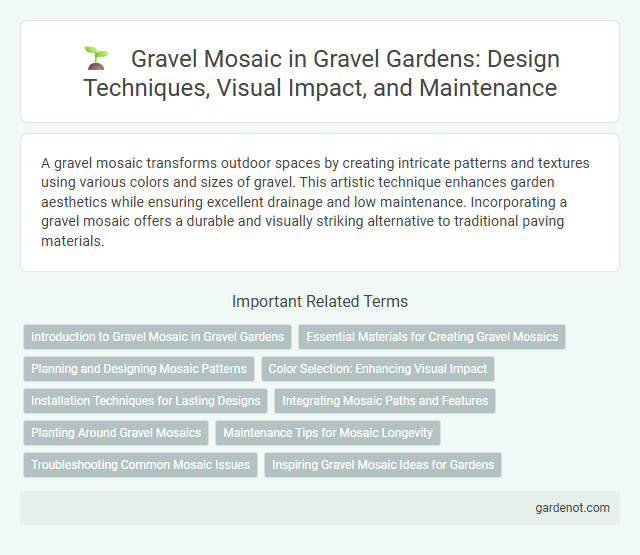A gravel mosaic transforms outdoor spaces by creating intricate patterns and textures using various colors and sizes of gravel. This artistic technique enhances garden aesthetics while ensuring excellent drainage and low maintenance. Incorporating a gravel mosaic offers a durable and visually striking alternative to traditional paving materials.
Introduction to Gravel Mosaic in Gravel Gardens
Gravel mosaic in gravel gardens creates intricate patterns using varied colors and sizes of gravel, enhancing aesthetic appeal and texture. This landscaping technique improves drainage and reduces soil erosion while offering a low-maintenance alternative to traditional garden beds. Gravel mosaics allow for creative design flexibility, integrating natural elements with functional garden pathways.
Essential Materials for Creating Gravel Mosaics
Essential materials for creating gravel mosaics include various types of gravel such as pea gravel, river rocks, and crushed stone, chosen for their contrasting colors and textures that enhance the design's visual appeal. A durable and permeable base layer, typically composed of compacted sand or crushed stone, ensures stability and proper drainage for the mosaic structure. Tools such as landscape fabric, edging materials, and grout or adhesive help secure the gravel pieces in place, maintaining the intricate patterns and longevity of the mosaic garden feature.
Planning and Designing Mosaic Patterns
Effective planning and designing of gravel mosaic patterns requires selecting appropriately sized and colored gravel to create visually striking contrasts and intricate shapes. Incorporating geometric or naturalistic designs enhances garden aesthetics while ensuring functionality and drainage. Careful layout marking and layering of gravel materials maintain pattern clarity and long-term durability in gravel garden installations.
Color Selection: Enhancing Visual Impact
Gravel mosaic color selection plays a crucial role in enhancing the visual impact of a gravel garden by creating striking contrasts and harmonious patterns. Choosing a blend of natural earth tones like rust, beige, and charcoal alongside vibrant hues such as terracotta or ochre amplifies texture and depth. Incorporating varied gravel sizes and shades optimizes light reflection and adds dynamic visual interest to outdoor spaces.
Installation Techniques for Lasting Designs
Gravel mosaic installation requires precise layering with a durable base of compacted crushed stone to ensure stability and prevent shifting over time. Interlocking patterns are created by carefully selecting and placing gravel pieces of various sizes and colors, enhancing both visual appeal and structural integrity. Using edging materials such as metal or stone borders helps contain the gravel, maintaining the design's form and longevity under varying weather conditions.
Integrating Mosaic Paths and Features
Gravel mosaic paths create visually striking patterns by combining various sizes and colors of gravel, enhancing garden aesthetics while providing durable walkways. Integrating mosaic features such as intricate designs or embedded stones adds unique focal points that complement surrounding plants and garden structures. Proper installation with a firm base and edging ensures stability, preventing gravel displacement and maintaining the crisp appearance of mosaic patterns over time.
Planting Around Gravel Mosaics
Planting around gravel mosaics enhances visual contrast and softens the hardscape texture, creating a balanced garden aesthetic. Selecting drought-tolerant plants like sedum, lavender, or thyme complements the porous drainage properties of gravel, promoting healthy root systems and reducing maintenance. Integrating low-growing, spreading plants within mosaic gaps not only stabilizes gravel placement but also introduces vibrant color and seasonal interest to the gravel garden.
Maintenance Tips for Mosaic Longevity
Gravel mosaic durability relies on regular maintenance such as removing debris, weed control, and occasional raking to preserve pattern clarity and prevent displacement. Applying a weed suppressant fabric beneath the gravel layer minimizes unwanted plant growth, reducing maintenance efforts. Periodic top-up of gravel and sealing with a stabilizing binder enhances the mosaic's structural integrity and aesthetic appeal over time.
Troubleshooting Common Mosaic Issues
Gravel mosaic issues often arise from uneven settling, causing displacement and gaps between stones that disrupt the pattern. Proper base preparation with compacted sand or crushed stone ensures stability and minimizes movement over time. Regular maintenance, including weed control and re-leveling displaced gravel, helps preserve the mosaic's visual appeal and structural integrity.
Inspiring Gravel Mosaic Ideas for Gardens
Gravel mosaics transform garden pathways and patios into stunning outdoor art pieces by using varied colors, shapes, and sizes of gravel to create intricate patterns and designs. Popular ideas include geometric shapes, floral motifs, and abstract compositions that add texture and visual interest while ensuring excellent drainage and low maintenance. Incorporating contrasting gravel tones such as white quartz, black basalt, and river pebbles enhances the mosaic's depth and durability for long-lasting garden appeal.
Gravel mosaic Infographic

 gardenot.com
gardenot.com